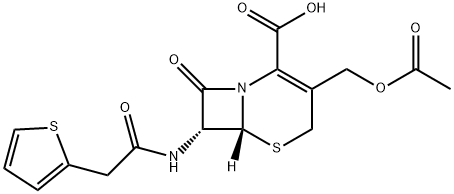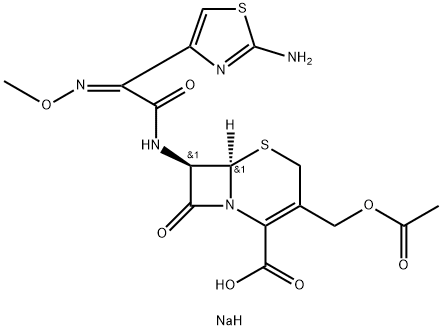Cephalothin sodium salt , 96% , 58-71-9
Synonym(s):
7-(2-Thienylacetamido)cephalosporanic acid sodium salt;Cephalothin sodium salt;Cephalotin sodium salt
CAS NO.:58-71-9
Empirical Formula: C16H16N2O6S2.Na
Molecular Weight: 418.42
MDL number: MFCD00072025
EINECS: 200-394-6
| Pack Size | Price | Stock | Quantity |
| 100MG | RMB47.20 | In Stock |
|
| 250mg | RMB63.20 | In Stock |
|
| 500MG | RMB87.20 | In Stock |
|
| 1G | RMB108.80 | In Stock |
|
| 5g | RMB334.40 | In Stock |
|
| others | Enquire |
PRODUCT Properties
| Melting point: | 240°C |
| alpha | D +135° (c = 1.0 in water) |
| storage temp. | Inert atmosphere,2-8°C |
| solubility | H2O: 50 mg/mL, clear, faintly yellow |
| form | Solid |
| color | White to Off-White |
| Water Solubility | 158 mg/L |
| Merck | 13,1994 |
| BRN | 4120706 |
| Stability: | Hygroscopic |
| CAS DataBase Reference | 58-71-9(CAS DataBase Reference) |
Description and Uses
Cefalothin is a β-lactam cephalosporin antibiotic. It inhibits the growth of various Gram-positive and Gram-negative bacteria, including several strains of S. pyogenes, S. aureus, C. tetani, N. gonorrhoeae, Salmonella, and Shigella (MICs = 0.1-0.2, 0.312-0.625, 0.078, 1.25, 1.56-6.25, and 3.12-12.5 μg/ml, respectively). Cefalothin binds to E. coli penicillin-binding proteins (PBPs; IC50s = <0.25, 16, 37, and 1 μg/ml for PBP1a, 1bs, 2, and 3, respectively, in a radioligand binding assay), which interferes with bacterial morphogenesis. It exhibits antibacterial activity in mouse models of infection with S. pyogenes, D. pneumoniae, and S. aureus. Formulations containing cefalothin were previously used in the prophylaxis and treatment of bacterial infections.
Antibacterial;Bacterial transpeptidase inhibitor
Safety
| Symbol(GHS) |  GHS08 |
| Signal word | Danger |
| Hazard statements | H317-H334 |
| Precautionary statements | P261-P280-P284-P304+P340-P342+P311 |
| Hazard Codes | Xn,Xi |
| Risk Statements | 42/43 |
| Safety Statements | 22-36/37 |
| WGK Germany | 2 |
| RTECS | XI0388300 |
| HS Code | 29419000 |
| Toxicity | LD50 in mice, rats (mg/kg): >20000, >10000 orally; 5670, 7716 i.p. (Kuramoto) |



